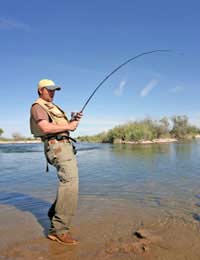Equipment for Coarse Fishing

Coarse fishing is the term used to describe fishing in freshwater for any species of fish apart from salmon and trout.
The places to fish are numerous and varied and range from reservoirs to deep rivers and canals. In these venues there are many species of fish. There are small fry such as bleak and gudgeon and there are large fish like pike, carp and barbel.
The equipment needed by the coarse angler depends on the conditions and the type of fish being hunted. For the novice angler the equipment needn't be too expensive or complicated.
Rods
Dedicated carp and pike fishermen use specialised rods that have the strength to handle large bait and powerful fish. Rods used for spinning tend to be small and compact and some have a securing mechanism on the handle to keep the reel in place.For the angler new to coarse fishing, the best choice is a general-purpose float rod. These rods are about 4 metres long and are quite light. They have a flexible action so that the float can be cast out smoothly. A long handle enables the angler to tuck the rod under the arm for more comfort.
Reels
The most popular reel used by the majority of coarse anglers is the fixed-spool reel. It has a simple arm system that picks up line when the handle is turned. A fixed-spool reel is easy to use and can be bought in different sizes.Larger reels hold more line, which is useful when fishing for barbel or carp. When hooked, these powerful fish will dash for freedom and are capable of stripping metres of line from the reel in seconds.
Centre pin reels are sometimes used for float fishing. They have a smooth running action but pulling out line for casting needs practise.
Anglers who specialise in catching large pike and huge catfish prefer to use a multiplier reel. However, multiplier reels in the hands of beginners have a tendency to overrun resulting in a tangled mess of knots and loops.
Lines and Hooks
For general-purpose fishing a line of 4lbs breaking strain is adequate. The line can hold a fish of more than 4lbs because being in water the fish is supported and therefore lighter. Sometimes, when fishing in strong flowing rivers and streams, the current can add extra "weight" to the fish and test the fishing line to its limit.Barbless hooks are the best choice because they do less damage to the fish and make the job of unhooking much quicker. When using maggots for bait, try a small hook of size 14 or 16. A larger hook is better when using lobworm, cheese or a cube of luncheon meat.
Floats and Legers
Floats are put on the line to carry bait down river or to suspend it in stillwater. Split shot is needed to balance the float in the water so that it stands up and is visible.Legers are the names of weights. Legering is the method used to keep bait on the riverbed or deep in gravel pits.
Extra Equipment
Waterproofs and boots are sensible items to have. A landing net with a telescopic handle can prove useful when bringing in a heavy fish. Keep scissors or nail cutters handy for cutting line and snipping tails off knots.Choosing equipment for the first time can be confusing. Talk to the people in the tackle shop. They are probably anglers and will offer good, friendly advice.
- Shads, Pirks and Other Lures
- Making and Using Particle Baits
- Using Dead Baits
- Making and Using Paste Baits
- Ten Top Tips for Sea Fishing Equipment
- Rod Accessories for Fishing
- What To Wear When Fishing
- Tents for Fishing
- Bait for Game Fishing
- Bait for Sea Fishing
- Equipment for Game Fishing
- Equipment for Sea Fishing
- Bait for Coarse Fishing


Re: Float Fishing
So I'm relatively new to fishing, to be honest I used to go with my dad and he used to set my rod up for me. I never tied rigs or anything so I guess…
Re: Fishing Holidays: Your Questions Answered
hi, i;m looking at getting a travel rod for mainly sea fishing but i also want to fish the occasional small pond…
Re: Trout Fishing
Hi, I’m trying to find somewhere I can go spinning for trout. I live near Swindon and dont mind a bit of travelling. I’ve searched online and every I…
Re: Trout Fishing
Hi I'm looking to fined out more about fly fishing for mullet and sea trout in Christchurch harbour...thank you.
Re: Equipment for Game Fishing
I know nothing about fishing tackle can you recommend a good rod reels line for fishing in the amazon and rivers in Guyana for large…
Re: Trout Fishing
Hi, where I can find places for trout fishing in norfolk?
Re: Fishing for Chub
This is a really good website and from this ive been catching chub on slugs maggots casters and worms rated 10 out of 10
Re: Is Fishing From a Road Bridge Over a River Legal?
Is it legal to fish next to a bridge without a permit even though the river is permitted
Re: Fishing For Flatfish
Hi im new to the whole fishing game but have recently been hooked onnit as i had a good day out with a keen fisherman. Will i catch plaice by…
Re: Getting Children Involved in Fishing
where in East Anglia is a good place to start to practice and teach my 6 year old girl to spin fish (lure angling…